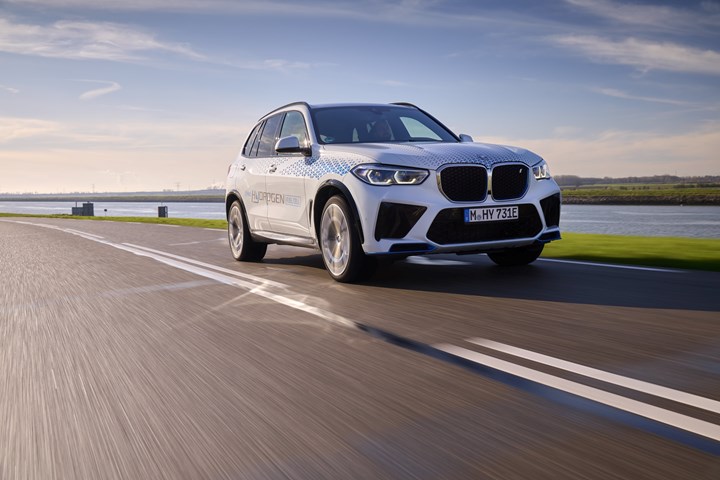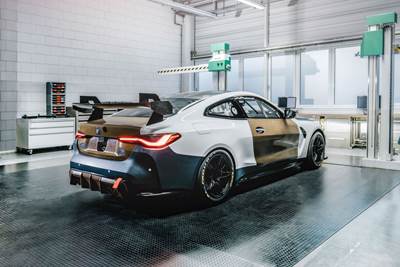BMW Group to bring iX5 Hydrogen pilot fleet into service in 2023
A fleet of under 100 vehicles, featuring BMW fuel cell technology and 700-bar CFRP storage tanks, will be deployed for international demonstration and trial purposes.
The BMW Group (Munich, Germany) presents the first vehicles in a pilot fleet that will go into service this year. After four years of development work, the BMW iX5 Hydrogen vehicle and development project is entering its critical next phase. The fleet of under 100 vehicles will then be employed internationally for demonstration and trial purposes for various target groups.
“Hydrogen is a versatile energy source that has a key role to play in the energy transition process and therefore in climate protection. After all, it is one of the most efficient ways of storing and transporting renewable energies,” Oliver Zipse, chairman of the Board of Management of BMW AG, says. “We should use this potential to also accelerate the transformation of the mobility sector. Hydrogen is the missing piece in the jigsaw when it comes to emission-free mobility. One technology on its own will not be enough to enable climate-neutral mobility worldwide.”
The BMW iX5 Hydrogen developed on the basis of the current BMW X5 was first unveiled as a concept at the IAA show in 2019. Initial prototypes were then made available at the IAA Mobility 2021 for visitors to experience in action as shuttle vehicles.
The pilot fleet feature the BMW Group’s hydrogen fuel cell technology, as well as two 700-bar tanks made of carbon-fiber reinforced plastic (CFRP) for hydrogen storage. The fuel cells are made at its in-house competence center for hydrogen in Munich, and are considered one of the core elements in the BMW iX5 Hydrogen, generating a high continuous output of 125 kilowatts/170 horsepower. In addition to the technological equivalents of features found on combustion engines, such as charge air coolers, air filters, control units and sensors, the BMW Group also developed special hydrogen components for its new fuel cell system. These include the high-speed compressor with turbine and high-voltage coolant pump, for instance. Individual fuel cells are sourced from Toyota Motor Corp., which BMW has been collaborating with on fuel cell drive systems since 2013.
The BMW Group sold more than 215,000 fully electric vehicles (EVs) worldwide in 2022, which represents an increase over the previous year of almost 108%.
The two CFRP tanks hold almost six kilograms of hydrogen, enough to give the BMW iX5 Hydrogen a range of 504 kilometers (313 miles) in the WLTP cycle. Filling up the hydrogen tanks only takes three to four minutes, according to BMW.
In combination with a highly integrated drive unit using fifth-generation BMW eDrive technology (the electric motor, transmission and power electronics are grouped together in a compact housing) at the rear axle and a power battery with lithium-ion technology developed specially for this vehicle, the powertrain channels maximum output of 295 kilowatts/401 horsepower onto the road. In coasting overrun and braking phases, the motor also serves as a generator, feeding energy back into a power battery.
The BMW iX5 Hydrogen is being built in the BMW Group’s pilot plant at its Research and Innovation Centre (FIZ) in Munich. Specialists in hydrogen technology, vehicle development and initial assembly of new models have been working closely together to integrate the drive and energy storage technology.
The BMW Group sold more than 215,000 fully electric vehicles (EVs) worldwide in 2022, which represents an increase over the previous year of almost 108%. EVs accounted for just under 9% of total sales volumes last year, and this share is set to increase to 15% in 2023.
In line with these developments, the BMW Group welcomes and supports activities to promote innovation in Germany and Europe that will help build a hydrogen economy and accelerate production of green hydrogen. These specifically include the large-scale hydrogen projects classified as Important Projects of Common European Interest (IPCEI).
Visit this link for a summary of the BMW iX5 Hydrogen’s technical data, performance, fuel consumption and range figures.
Read “BMW rolls out multi-material Carbon Cage with 2022 iX vehicle line” for information about BMW’s use of composites for iX vehicles.
Related Content
Materials & Processes: Resin matrices for composites
The matrix binds the fiber reinforcement, gives the composite component its shape and determines its surface quality. A composite matrix may be a polymer, ceramic, metal or carbon. Here’s a guide to selection.
Read MoreASCEND program update: Designing next-gen, high-rate auto and aerospace composites
GKN Aerospace, McLaren Automotive and U.K.-based partners share goals and progress aiming at high-rate, Industry 4.0-enabled, sustainable materials and processes.
Read MoreNovel dry tape for liquid molded composites
MTorres seeks to enable next-gen aircraft and open new markets for composites with low-cost, high-permeability tapes and versatile, high-speed production lines.
Read MoreProtecting EV motors more efficiently
Motors for electric vehicles are expected to benefit from Trelleborg’s thermoplastic composite rotor sleeve design, which advances materials and processes to produce a lightweight, energy-efficient component.
Read MoreRead Next
Alauda Aeronautics debuts crewed flying race car
In a fusion of UAM and motorsport, the composite Airspeeder Mk4 is designed to set the bar for performance and technology for the Airspeeder Racing Championship in 2024.
Read MoreBMW unveils new M4 GT4 race car, features most natural fiber parts for GT series to date
Bcomp ampliTex and powerRibs technologies make up bodywork components such as the hood, front splitter, doors, trunk and rear wing and several interior components, taking next steps for future production models.
Read MoreComposites end markets: Energy (2024)
Composites are used widely in oil/gas, wind and other renewable energy applications. Despite market challenges, growth potential and innovation for composites continue.
Read More










.jpg;maxWidth=300;quality=90)
















